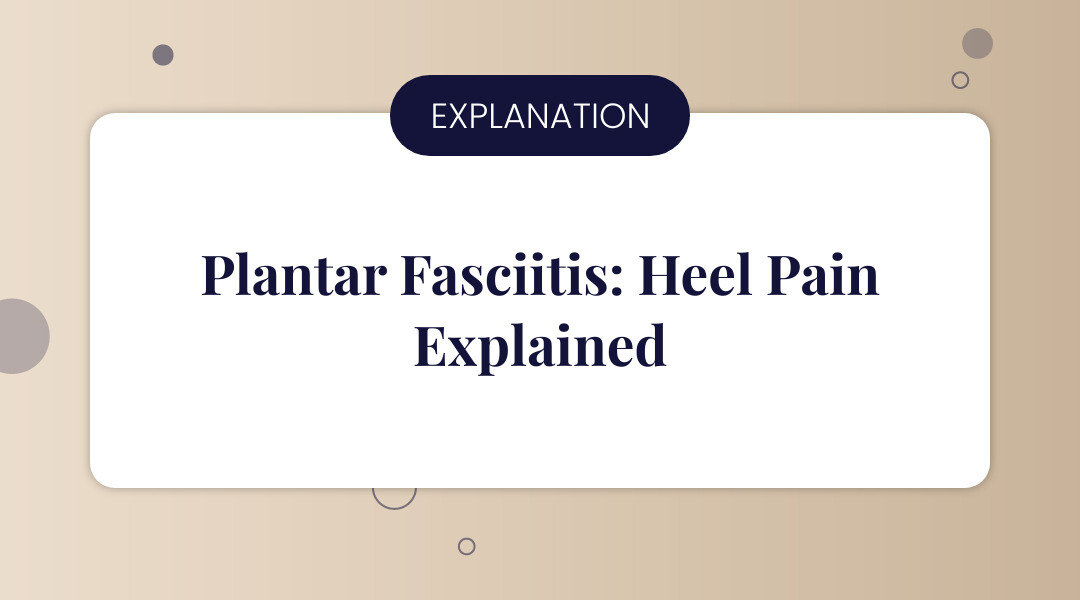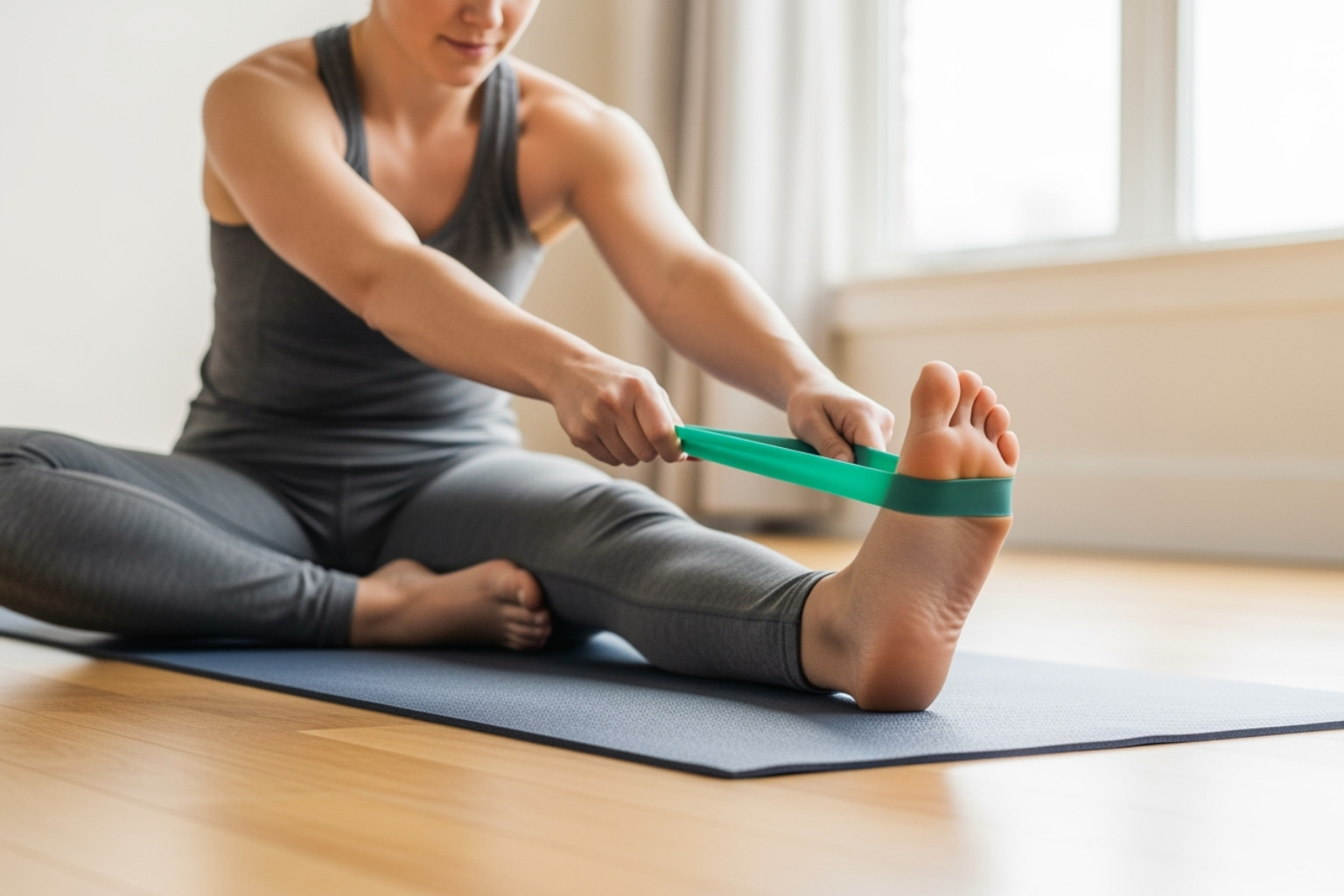Why Plantar Fasciitis Relief Matters for Your Daily Comfort
Plantar fasciitis causes a sharp, stabbing heel pain that can make every step agonizing. Finding effective plantar fasciitis relief is essential for your daily comfort. Here are proven solutions:
Quick Relief Methods:
- Rest and ice the affected foot for 15-20 minutes, 3-4 times daily
- Perform daily stretches targeting the plantar fascia and calf muscles
- Apply topical pain relief creams with menthol and aloe for targeted comfort
- Wear supportive footwear with proper arch support and cushioning
- Use night splints to maintain a gentle stretch while sleeping
- Try orthotics or inserts to distribute pressure evenly
Most people see significant improvement within several months with conservative treatment. About 90% of patients respond favorably to non-surgical measures, and only 5% ever need surgery.
Affecting about 10% of Americans, plantar fasciitis is the most common cause of heel pain. It results from inflammation or damage to the tissue band connecting your heel to your toes. The signature morning pain occurs when this stiffened tissue tears slightly upon standing.
The good news is that relief is achievable through a combination of rest, exercises, proper footwear, and effective topical solutions like natural pain relief creams containing aloe, menthol, and urea.
I'm Tony Enrico of Neuropasil. I've seen thousands of active individuals find effective plantar fasciitis relief by combining natural topical treatments with proper foot care. Our mission is to help 1 million people overcome aches and pains by 2028, and plantar fasciitis is a common challenge we help address.

Understanding Plantar Fasciitis: The Root of Your Heel Pain
If you've ever felt a sharp, stabbing pain in your heel first thing in the morning, you're familiar with the hallmark symptom of plantar fasciitis. To find lasting plantar fasciitis relief, it helps to understand the cause.
Your plantar fascia is a thick tissue band along the bottom of your foot, acting as a shock-absorbing bowstring. Plantar fasciitis occurs when this band is strained, leading to tiny tears. While often called inflammation, chronic cases are typically degenerative, meaning the tissue is breaking down from repeated stress.
The stabbing heel pain is your body's alarm. It's worst in the morning because the fascia tightens overnight and stretches abruptly when you stand. The pain often subsides with movement but can return after periods of rest. For more insight, see our guide on Heel Pain.
The primary cause is overuse injuries. A new running routine, a job that requires standing all day, or a sudden increase in activity can push your foot beyond its limits. Improper footwear is another major culprit. Worn-out shoes lacking arch support force the plantar fascia to overwork. Walking barefoot on hard surfaces also adds significant strain. Our article on Plantar Fasciitis Shoes offers guidance.
Several risk factors increase your chances of developing plantar fasciitis:
- Obesity places extra stress on your feet.
- Age plays a role, with most cases occurring between 40 and 60.
- Foot structure, such as flat feet or high arches, can alter walking mechanics.
- High-impact activities like running and dancing put you at higher risk.
- Tight calf muscles can limit ankle flexibility, straining the fascia.
The diagnosis process is usually straightforward. A doctor will perform a physical exam to locate the pain and assess your foot's flexibility and structure. They'll ask about your symptoms and activity levels. X-rays are sometimes used to rule out other issues like stress fractures but aren't needed to diagnose plantar fasciitis itself.
You can learn more in our guide What is Plantar Fasciitis. Take heart: plantar fasciitis is a common condition affecting roughly 10% of people. Understanding the cause is the first step toward effective plantar fasciitis relief.
First Steps to Relief: At-Home Strategies and Exercises
When heel pain strikes, you want immediate relief. Fortunately, most cases of plantar fasciitis improve with simple, consistent at-home treatments.

Start with the RICE method. Rest by avoiding activities that aggravate your heel. Apply Ice for 15-20 minutes several times a day to reduce inflammation; a frozen water bottle rolled under the arch works well for both icing and massage. Compression with a soft wrap can offer support, and Elevation helps reduce swelling.
Your footwear is critical. Ditch worn-out sneakers and choose supportive footwear with good arch support and cushioning. Avoid walking barefoot on hard surfaces. Shoe inserts or custom orthotics can also provide significant relief. For more details, see our article on Plantar Fasciitis Shoes.
For targeted comfort, apply a quality topical cream directly to the painful area. Active ingredients like menthol, aloe, and urea penetrate the skin to soothe inflammation right at the source. At Neuropasil, our cream is formulated for this kind of targeted relief, helping to manage daily discomfort. Find more tips in Step Up Your Comfort: Remedies for Aching Feet.
Effective Stretches for Plantar Fasciitis Relief
Consistent stretching is one of the most effective ways to manage plantar fasciitis. According to research, stretching can reduce tension in the plantar fascia. Make it a daily habit, especially before getting out of bed.
- Calf Stretch: Face a wall with your hands on it. Step one foot back, keeping the heel down and leg straight. Lean forward until you feel a stretch in your calf. Hold for 30 seconds. Repeat 3-5 times per leg.
- Seated Plantar Fascia Stretch: While seated, cross the affected foot over your opposite knee. Gently pull your toes back toward your shin until you feel a stretch in your arch. Hold for 30 seconds. Repeat 3-5 times. This is ideal to do before getting out of bed.
- Towel Stretch: Sit with your legs straight out. Loop a towel around the ball of your affected foot and gently pull it toward you, keeping your knee straight. Hold for 30 seconds. Repeat 3-5 times.
For more exercises, visit our guide on Exercises for Plantar Fasciitis.

Strengthening Exercises and Self-Massage
While stretching increases flexibility, strengthening the muscles in your feet builds long-term resilience.
- Towel Curls: Sit with your feet flat on the floor. Use your toes to scrunch a towel on the floor toward you. Repeat 10-15 times.
- Marble Pickups: Use your toes to pick up marbles from the floor and place them in a cup. Repeat 10-15 times.
Self-massage can also provide relief and promote healing. Ice massage is particularly effective: roll a frozen water bottle under your arch for 5-10 minutes to reduce inflammation and massage the tissue. The American Academy of Family Physicians explains how to perform an ice massage in detail. You can also roll a golf or tennis ball under your foot while seated to control the pressure on tender spots, releasing tension and increasing blood flow.
Combining these exercises with rest, supportive footwear, and topical relief like Neuropasil cream creates a comprehensive plan for lasting plantar fasciitis relief.
The Soothing Power of Topical Creams for Plantar Fasciitis Relief
When you have stabbing heel pain, topical creams offer fast, targeted relief. They work directly at the source of pain, avoiding the systemic effects of oral medications. The active ingredients absorb through the skin to reduce local inflammation and provide a numbing sensation exactly where you need it.
Neuropasil uses a blend of natural ingredients to soothe foot pain. Menthol provides an immediate cooling and numbing sensation. Aloe Vera calms irritated tissue with its anti-inflammatory properties. And Urea softens the skin, helping the other active ingredients penetrate more deeply. This natural formula provides powerful relief without harsh chemicals, making it a favorite among our customers for managing everything from plantar fasciitis to post-workout soreness.
To apply, massage a thin layer into your heel and arch until absorbed. Use it several times a day—after stretching, after an ice massage, or before bed to help reduce morning stiffness. For a broader look at topical solutions, check out Foot Pain Relief Creams.
Here's how each key ingredient contributes to your comfort:
| Ingredient | Primary Benefit for Plantar Fasciitis | How It Works |
|---|---|---|
| Menthol | Numbing & Cooling Sensation | Activates cold receptors, distracts from pain |
| Aloe Vera | Soothing & Anti-inflammatory | Calms irritated tissue, moisturizes skin |
| Urea | Improved Penetration & Moisturizing | Softens skin, improves absorption of other actives |
The combination of these powerhouse ingredients makes Neuropasil an effective natural topical option for plantar fasciitis relief. When paired with proper stretching and supportive footwear, you're giving yourself the best chance at reclaiming your active lifestyle.
When Home Care Isn't Enough: Professional Medical Treatments
While home care is effective for most, persistent pain may require professional medical treatment. If your pain doesn't improve, it's time to see a doctor.
Consult a healthcare provider if your pain lasts more than a few weeks despite home treatment, if it worsens, or if it severely impacts your daily life. Seek immediate attention for any numbness, tingling, or weakness in your foot. A doctor, podiatrist, or orthopedic specialist has several advanced treatment options.
- Physical Therapy: A physical therapist can create a custom program of stretches and exercises. They may also use taping techniques to support your foot and analyze your gait to reduce strain.
- Night Splints: These devices hold your foot in a gentle stretch overnight, preventing the fascia from tightening and reducing morning pain.
- Corticosteroid Injections: These shots deliver powerful anti-inflammatory medication directly to the painful area for short-term relief. However, they are used sparingly as multiple injections can weaken the fascia.
- Platelet-Rich Plasma (PRP) Injections: This treatment uses your own concentrated platelets to potentially promote tissue healing, though research is still evolving.
- Extracorporeal Shock Wave Therapy (ESWT): For chronic cases, this non-invasive option uses sound waves to stimulate healing.
- Ultrasonic Tissue Repair: This is another minimally invasive procedure that uses ultrasound guidance to remove damaged tissue.
The good news is that surgery is a last resort, needed by only about 5% of patients after 6-12 months of failed conservative treatments. Your provider will help you choose the right treatment based on the severity and duration of your pain.
The key takeaway is not to suffer in silence if home treatments aren't working. Professional help is available. For a comprehensive overview of medical options, the Mayo Clinic offers detailed guidance.
Recovery and Preventing Future Flare-Ups

Achieving plantar fasciitis relief is just the first step; preventing future flare-ups is key to staying active and pain-free long-term.
Patience is required for recovery. While some feel better in weeks, complete resolution can take several months. However, about 90% of people see significant improvement within 10 months of consistent conservative treatment. Plantar fasciitis can become chronic or recur, which makes prevention essential. A study examining long-term outcomes confirms that recurrence is possible, highlighting the need for proactive habits.
To protect yourself from future flare-ups, adopt these strategies:
- Maintain a healthy weight. This reduces daily stress on your plantar fascia.
- Choose supportive shoes. Always wear shoes with good arch support and cushioning. Avoid walking barefoot on hard surfaces and replace worn-out athletic shoes regularly.
- Stretch daily. Continue your calf and plantar fascia stretches even after the pain is gone to maintain flexibility.
- Modify activities. Incorporate low-impact exercises like swimming or cycling to give your feet a break from constant pounding.
- Listen to your body. Address any returning twinges of pain immediately with rest and ice to prevent a full-blown flare-up.
By weaving these protective habits into your daily life, you're not just managing symptoms—you're building lasting resilience that keeps your feet strong and comfortable.
Frequently Asked Questions about Plantar Fasciitis
We hear from people every day who are searching for plantar fasciitis relief, and many of them have similar questions. Let's address some of the most common concerns.
What is the fastest way to cure plantar fasciitis?
There is no instant cure, but you can find relief quickly by consistently combining several strategies. The fastest approach combines rest from aggravating activities, regular icing, daily stretching, and wearing supportive footwear.
Applying a topical cream like Neuropasil provides targeted, soothing comfort that helps you stay consistent with your other treatments. Consistency is the secret. Diligently applying this combination approach leads to significant improvement for most people, with about 90% of patients responding favorably to these conservative measures within 10 months.
Can stretching alone fix plantar fasciitis?
Stretching is a powerful tool for recovery. It reduces tension in the plantar fascia and calf muscles, improves flexibility, and promotes healing.
However, stretching alone is rarely enough. It's a critical piece of a comprehensive plan that should also include supportive footwear, rest, and other treatments. Think of it as a vital part of the solution, not the entire solution. Skipping it would significantly slow your recovery.
Why does rolling a ball under my foot help with pain?
Rolling a ball under your foot is a simple and effective self-care technique for several reasons:
- Massage: The motion works out tightness and breaks up adhesions in the plantar fascia.
- Increased Blood Flow: The pressure stimulates circulation, bringing nutrients to the area and removing inflammatory byproducts, which is essential for healing.
- Pain Relief: The sensation of the massage can help override pain signals to the brain. Using a frozen water bottle adds the benefit of cold therapy to reduce inflammation.
- Dynamic Stretch: It provides a gentle, controlled stretch to the fascia.
Conclusion
If you're battling the sharp heel pain of plantar fasciitis, you now have a roadmap to relief. The solution isn't a single magic bullet but a combination of proven strategies that address your pain from multiple angles.
We've covered the importance of rest, ice, and supportive footwear. We've also highlighted daily stretches that reduce tension and prevent the micro-tears that cause pain. For targeted comfort, natural topical solutions like Neuropasil's unique blend of Menthol, Aloe, and Urea can soothe inflammation and numb pain right at the source. Combining our cream with stretching and proper footwear is a game-changer for many.
Remember to consult a healthcare professional if home care isn't enough after a few weeks. Professional treatments are available to help. The ultimate victory is prevention. Maintaining a healthy weight, wearing supportive shoes, and making stretching a daily habit are your best defense against future flare-ups. With conservative treatment, about 90% of people find significant relief.
You deserve to walk without pain. By embracing this comprehensive approach—combining home care, proper footwear, and targeted topical treatments—you are reclaiming your comfort and mobility, one step at a time. For more guidance on how topical solutions can support your overall foot health, explore The Complete Guide to Effective Foot Pain Creams.
Your journey to lasting plantar fasciitis relief starts today. You've got this.
References
- Prevalence and Diagnosis: National Center for Biotechnology Information. (2023). Plantar Fasciitis. https://www.ncbi.nlm.nih.gov/books/NBK431073/
- Stretching and Rehabilitation: American Academy of Orthopaedic Surgeons. (2017). Foot and Ankle Conditioning Program. https://orthoinfo.aaos.org/globalassets/pdfs/2017-rehab_foot-and-ankle.pdf
- Home Treatment and Prognosis: American Academy of Family Physicians. (2019). Plantar Fasciitis: A Review of Treatment. https://www.aafp.org/pubs/afp/issues/2019/0615/p744.html
- Medical Treatment Options: Mayo Clinic. (2022). Plantar Fasciitis: Diagnosis & Treatment. https://www.mayoclinic.org/diseases-conditions/plantar-fasciitis/diagnosis-treatment/drc-20354851
- Long-Term Outcomes: National Center for Biotechnology Information. (2018). Long-Term Prognosis of Plantar Fasciitis: A 5- to 15-Year Follow-up Study. https://www.ncbi.nlm.nih.gov/pmc/articles/PMC5844527/














